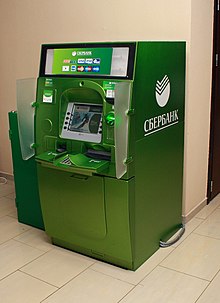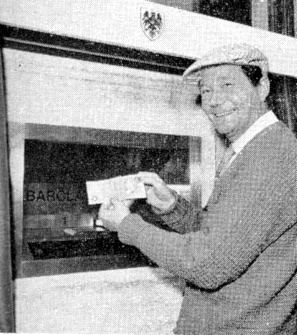The idea of out-of-hours cash distribution developed from bankers' needs in Asia (Japan), Europe (Sweden and the United Kingdom) and North America (the United States).[8][9][10]Little is known of the Japanese device other than it was called "Computer Loan Machine" and supplied cash as a three-month loan at 5% p.a. after inserting a credit card. The device was operational in 1966.[11][12]
In the US patent record, Luther George Simjian has been credited with developing a "prior art device". Specifically his 132nd patent (US3079603), which was first filed on 30 June 1960 (and granted 26 February 1963). The roll-out of this machine, called Bankograph, was delayed by a couple of years, due in part to Simjian's Reflectone Electronics Inc. being acquired by Universal Match Corporation.[13] An experimental Bankograph was installed in New York City in 1961 by the City Bank of New York, but removed after six months due to the lack of customer acceptance. The Bankograph was an automated envelope deposit machine (accepting coins, cash and cheques) and did not have cash dispensing features.[14][15]
It is widely accepted that the first cash machine was put into use by Barclays Bank in its Enfield Town branch in north London, United Kingdom, on 27 June 1967.[16] This machine was inaugurated by English comedy actor Reg Varney.[17] This instance of the invention is credited to the engineering team led by John Shepherd-Barron of printing firm De La Rue,[18] who was awarded an OBE in the 2005 New Year Honours.[19][20] Transactions were initiated by inserting paper cheques issued by a teller or cashier, marked with carbon-14 for machine readability and security, which in a latter model were matched with a six digit personal identification number(PIN).[18][21] Shepherd-Barron stated; "It struck me there must be a way I could get my own money, anywhere in the world or the UK. I hit upon the idea of a chocolate bar dispenser, but replacing chocolate with cash."[18]
The Barclays-De La Rue machine (called De La Rue Automatic Cash System or DACS)[22] beat the Swedish saving banks' and a company called Metior's machine (a device called Bankomat) by a mere nine days and Westminster Bank’s-Smith Industries-Chubb system (called Chubb MD2) by a month.[23] The online version of the Swedish machine is listed to have been operational on 6 May 1968, while claiming to be the first online cash machine in the world (ahead of a similar claim by IBM and Lloyds Bank in 1971).[24] The collaboration of a small start-up called Speytec and Midland Bank developed a fourth machine which was marketed after 1969 in Europe and the US by the Burroughs Corporation. The patent for this device (GB1329964) was filed on September 1969 (and granted in 1973) by John David Edwards, Leonard Perkins, John Henry Donald, Peter Lee Chappell, Sean Benjamin Newcombe &
Malcom David Roe.
Malcom David Roe.
Both the DACS and MD2 accepted only a single-use token or voucher which was retained by the machine while the Speytec worked with a card with a magnetic stripe at the back. They used principles including Carbon-14 and low-coercivity magnetism in order to make fraud more difficult.
The idea of a PIN stored on the card was developed by a British engineer working on the MD2 named James Goodfellow in 1965 (patent GB1197183 filed on 2 May 1966 with Anthony Davies). The essence of this system was that it enabled the verification of the customer with the debited account without human intervention. This patent is also the earliest instance of a complete "currency dispenser system" in the patent record. This patent was filed on 5 March 1968 in the US (US 3543904) and granted on 1 December 1970. It had a profound influence on the industry as a whole. Not only did future entrants into the cash dispenser market such as NCR Corporation and IBM licence Goodfellow’s PIN system, but a number of later patents reference this patent as "Prior Art Device".[25]













No comments:
Write comments